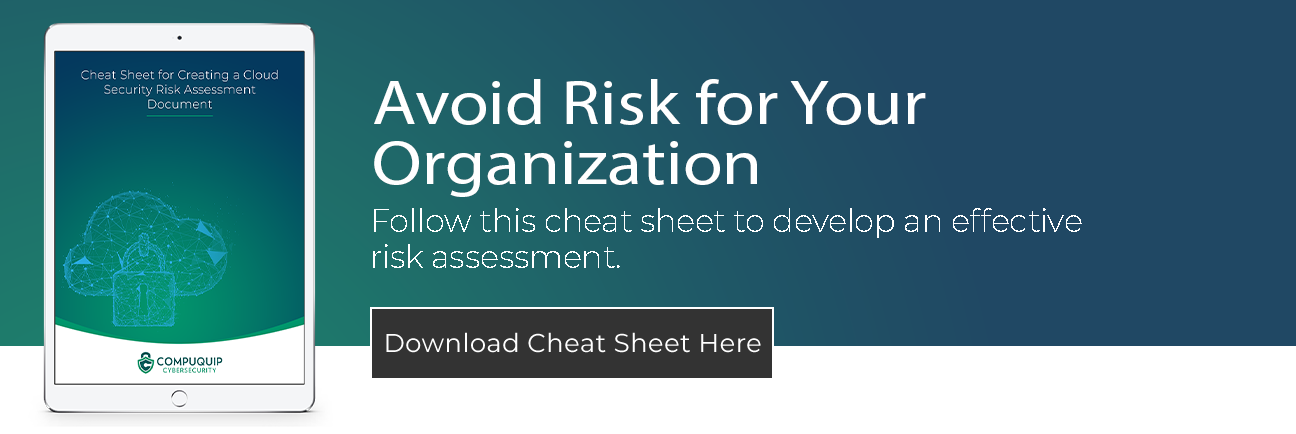7 Cloud Security Challenges and Risks to Be Aware Of
The “cloud” (a term for remote computing resources) has become an inextricable part of modern business. Organizations all over the world use cloud-based services such as platform-as-a-service (PaaS), software-as-a-service (SaaS), or infrastructure-as-a-service (IaaS). These cloud services help organizations expand their capabilities while minimizing their capital expenditures and labor costs for adding new technology solutions.
When adopting cloud solutions, many organizations fail to balance the benefits of the cloud against the cloud security threats and challenges they may face. These cloud security challenges and risks need to be property addressed before a cloud solution is adopted by the organization.
Who’s Responsible for Security in the Cloud?
There are several key components to security in any infrastructure—and the cloud is no exception. What is different about security in the cloud is where the responsibility for managing different security components lies.
With an on-premises solution, your organization is solely responsible for all aspects of security. In the cloud, a cloud service provider (CSP) may take responsibility for certain components of their infrastructure. Here’s a table showing the typical allocation of responsibility for different IT security components for specific types of cloud services:
|
Responsibility for Key Security Components in the Cloud |
|||
|
IT Security Component |
IaaS |
PaaS |
SaaS |
|
User Access |
You |
You |
You |
|
Data |
You |
You |
You |
|
Applications |
You |
You |
CSP |
|
Operating System (OS) |
You |
CSP |
CSP |
|
Network Traffic |
You |
CSP |
CSP |
|
Hypervisor |
CSP |
CSP |
CSP |
|
Infrastructure |
CSP |
CSP |
CSP |
|
Physical |
CSP |
CSP |
CSP |
It’s important to note that this table only represents a typical allocation of responsibility. Some cloud service providers may have different allocations of responsibility outlined in their service agreements. So, it’s important to read those agreements (or have your legal and IT security experts read them) before signing on.
However, as you may have noticed, in every cloud service type, there is always some responsibility assigned to the cloud service user (i.e. you). CSPs rarely assume responsibility for data breaches caused by user access issues or the insecure storage, transmission, or use of data.
What are the biggest cloud security challenges and risks that companies need to be aware of? More importantly, how can cloud computing security issues and challenges be resolved?
Here’s a list of some cloud security risks and solutions for businesses to consider:
Cloud Security Challenge #1: A Lack of Visibility/Control
One of the biggest benefits of using cloud-based technologies is that the customer doesn’t have to manage the resources needed to keep it working (such as servers). However, handing off the responsibility for managing the day-to-day maintenance of a software, platform, or computing asset can result in having less visibility and control over that asset.
Why is this one of the more important cloud security challenges that organizations need to address?
Because, it affects the ability of the organization to:
- Verify the efficacy of their security controls (because there’s no visibility into the tools and data on the cloud platform);
- Enact incident response plans (since they may not have complete control over cloud-based assets); and
- Analyze information about their data, services, and users (which is often necessary to recognize abnormal use patterns inherent to a security breach).
When adding a cloud-based service to the organization’s workflows, it is important for the organization to hammer out the details about what data can be accessed, how it can be tracked, and what security controls the cloud provider uses to prevent data breaches. This is crucial for verifying how much visibility and control the cloud solution will offer.
Cloud Security Challenge #2: Some Cloud Platforms May Not Comply with Industry Regulations
Organizations often have to meet special regulatory compliance requirements, such as HIPAA, PCI DSS, GDPR, or FISMA. Failure to meet these standards can result in censures, fines, and other penalties that negatively impact the business. Unfortunately, not all cloud service providers have security measures that comply with every industry regulation.
Adding a cloud-based service without checking if it meets industry-required regulatory standards is a major problem. This cloud security risk leaves the business open to audits and penalties.
The simplest solution is to verify with the cloud service provider which regulatory standards they meet, and then check with the appropriate agencies if they are listed as being compliant. If no “approved companies” database exists for the compliance standard being checked for, it may be necessary to study the standard’s requirements and check to see if the CSP has security measures that meet them.
Cloud Security Challenge #3: Data Privacy Issues
Here’s a scenario to consider:
Bob works for a financial services company that just added a PaaS solution to their workflows, and has no idea when and how to use it. He doesn’t know that the company only acquired the service for its general company bookkeeping needs, and uploads some client data to it because he figures the software on the platform will be useful for managing his accounts.
A few weeks later, the cloud provider suffers a data breach. All of Bob’s clients get their identities stolen and their bank accounts drained. Now, the company is under investigation because that client data should never have been on the cloud server. Worse, the company may be facing millions in fines and personal lawsuits seeking damages.
If a cloud service doesn’t have strong cybersecurity, moving sensitive data to it could expose that data to theft. Even with strong cybersecurity measures, moving data to the cloud could be a violation of data privacy agreements between the company and its customers. This could lead to fines and business restrictions (not to mention angry customers).
Cloud Security Challenge #4: Notifying Customers Affected by Data Breaches
One of the problems with not having absolute control and visibility of a network is that if the network is compromised, then it can be difficult to establish what resources and data have been affected. With a cloud service, if it doesn’t offer strong visibility features and access to event logs, then it can be nearly impossible to identify which customers have been affected by a data breach and what data was compromised.
If a breach occurred in such conditions, it would be necessary to assume a worst-case scenario and notify everyone whose data might have possibly been on the cloud platform. It would be the only way to be sure that data breach notifications reached everyone.
To avoid this issue, it’s necessary to check what kind of event logging solutions the cloud provider has—and what level of access they can provide to those event logs.
Cloud Security Challenge #5: User Access Control
As one of the components that is almost always the user’s responsibility, user access control is a crucial challenge for cloud security no matter what type of cloud service is used. However, as with on-premises security solutions, user access control in the cloud can be difficult—especially if the cloud service doesn’t have very robust control settings.
When choosing a cloud service, whether it’s an IaaS, PaaS, or SaaS solution, it’s important to check the user access controls that come with the solution—or if it is possible to augment those controls with additional tools and integrations.
Cloud Security Challenge #6: Vendor Lock-In for Security Features
One major potential challenge is the risk of “vendor lock” when it comes to security features. Being restricted to a single compatible security solution choice for a cloud service is extremely limiting—and it can lead to poor return on investment for security. This is because the vendor whom you’re locked in to doesn’t have to compete with other vendors—they have your business because you’re their only choice if you want something functional without having to start over from scratch.
When choosing cloud-based services, it’s important to check to see how easy it would be to migrate from that service to another one. For example, is your data stored in a format that is easy to export to a different system? Does the CSP provide exporting tools to help with that? Does the cloud service have a lot of different integrations/interfaces for different services and security features?
Checking this before choosing a cloud computing solution is crucial for avoiding vendor lock (for either your security solutions or the cloud service itself).
Cloud Security Challenge #7: Lack of Personnel Experienced in Cloud Security Measures
There’s a consistent challenge to find qualified security experts for any kind of production environment. This problem can be exacerbated with the cloud, as not everyone will be familiar with the security measures that the solution will use right off the bat.
Finding qualified personnel to manage cloud computing security solutions is incredibly difficult. However, managed security service providers (MSSPs) are often familiar with a wide range of security tools and can put a team of experts at your disposal on a moment’s notice for a fraction of the cost of recruiting, onboarding, training, and paying a similarly-skilled staff of in-house security experts.
Make Sure to Run a Cloud Security Risk Assessment
Before adding a cloud service to the organization’s workflows, it is vital to run a cloud security risk assessment. This risk assessment involves identifying what the biggest risks are, what their impacts would be, and how likely each risk is to occur.
By creating a cloud security risk assessment document, an organization can analyze cloud solutions with an eye towards their specific security needs. This helps to address some of the biggest cloud security challenges and risks that the organization faces. Need assistance creating a cloud security risk assessment plan? Reach out to the experts at Compuquip today!


